A Dynamic Cooperative Scheme with Multiple Antennas for Indoor Mobile Robot Localization
Abstract
This paper proposes a spatial cooperative diversity and decision-making technique to enhance signal detection and indoor mobile robot positioning performance of a global positioning satellite system (GNSS) receiver. Though the adaptive antenna array technique in early research could effectively promote antijamming freedom, overcome time-varying system, and mitigate narrowband and wideband interferences, factors such as the decrease of signal magnitude caused by obstacles (especially in the indoor environment), multipath, and blanking effect caused by the change in antenna direction with the motion of mobile robot can degrade the detection and interference mitigation performance of GNSS receivers. This paper aims to develop a dynamic cooperative scheme to proceed with the switch, selection, combination, and optimization among antennas. In addition, a signal processing experimental platform is also established to receive actually indoor GNSS signals for verification. The proposed scheme is capable of effectively promoting the postcorrelation signal-to-noise ratio (SNR) capability of a GNSS receiver under the indoor environment.
1. Introduction
The global navigation satellite system (GNSS) signal can be considered as a combination of signal power, carrier, spread code, and navigation message, which includes intended and unintended interferences. Once the receiver gets the navigation messages of more than four satellites, then the user position, velocity, and timing can be calculated through internal core processing of the receiver. However, how to overcome the external uncertainty factor (such as interference, and noise) is the problem concerning most of the scholars and, particularly, how to make indoor positioning efficient through the use of the receiver. Generally, the present Global Positioning System (GPS) does not function well in indoor or urban canyon multipath environments, which are regarded as difficult environments. It is hard to copy the attenuated and multipath faded signals caused by transmission around and through concrete and steel building structures.
Klukas et al. analyze the attenuation level of navigation signal through the signal reflected by different materials in indoor environment. The results demonstrate that the attenuation level of signal is between 0.5 and 23 dB [1]. Many scholars provide techniques to improve signal detection probability in indoor environment [2, 3]. The most common method is so called assisted-GPS (A-GPS) [4]. This method provides positioning information from a remote server in the cellular base station through wireless network. Nevertheless, GNSS suppliers expect the indoor positioning system to operate independently without wireless network and also maintain high positioning accuracy. It is difficult to obtain high positioning precision without any assisting device (such as WiFi, UWB, and ZigBee). In the current technique, the use of multiple antennas array combination method seems promising to be able to achieve indoor positioning. Tasi et al. propose Laplacian energy distribution model to derive spatial fading function under circular antenna array [5]. This attenuation signal model is often adopted to simulate and analyze communication channel response in indoor environment.
In early communication systems, the most common method was the use of antenna array with space-time coding or cooperation to increase system capacity under fading environment [6]. This technique was applied to interference suppression in multiinput multioutput (MIMO) system or navigation system later [7, 8]. In recent years, some antenna array processing techniques with intelligent and switching algorithms are proposed against the narrowband/wideband interferences, mutual coupling, and noise [9–11]. However, the application of these methods to GNSS positioning is still at initial stage.
Dietrich Jr. et al. first propose the concept of antenna array in indoor environment. This method utilizes spatial diversity characteristic for antenna array to enhance the signal-to-noise (SNR) ratio [12]. After that, Chiau and Gao not only use this technique in MIMO system to increase the channel capacity but also apply it to mobile device for future Galileo navigation system [13, 14]. The core concept is that each antenna maintains a certain distance from other antennas, and then the independent fading signal is received from each antenna. Thus, the multiple antennas combination method can be applied in this system to increase signal detection probability and SNR.
Broumandan et al. utilize the concept of diversity technique to achieve 7 dB signal processing gain for mobile navigation device in indoor environment [15].Zaheri et al. propose spatial diversity technique using two antennas, which results in 5 dB diversity gain enhancement and effectively suppresses multipath fading effect [16]. This paper proposes dynamic cooperative scheme based on the concept of antenna diversity characteristics. Through the antenna combination and decision logic process, the proposed scheme improves the signal detection probability under indoor environment. Unlike the diversity method proposed earlier [17, 18], this paper provides a dynamic switching and selection process for antenna array system. The experiments are also conducted with a mobile robot in indoor environment, and analysis and evaluation are demonstrated in this paper.
2. Methodology
The goal of antenna diversity technique is to mitigate the fading and improve the overall quality of the radio link. The basic principle is that the receiver combines more than one copy of a satellite signal where each copy is received through a different branch. As for GNSS applications, the receiver must be able to detect a weak navigation signal with −140 to −160 dBm power strength under outdoor environment [19]. Once the signal is masked or blanked, it is difficult for the receiver to position the user location due to signal attenuation. Thus, some diversity methods, including frequency diversity, time diversity, and antenna diversity, are proposed to solve this problem. In the following section, the dynamic cooperative scheme is demonstrated as a measure of effectiveness for multiple antennas.
2.1. Signal Model
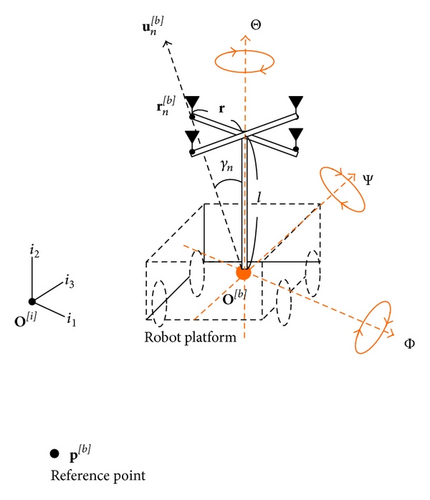
2.2. Prediversity Process
The detection performance of weak indoor navigation signal can be enhanced through multiple antennas combination method, such as polarization diversity, spatial diversity, and pattern diversity.

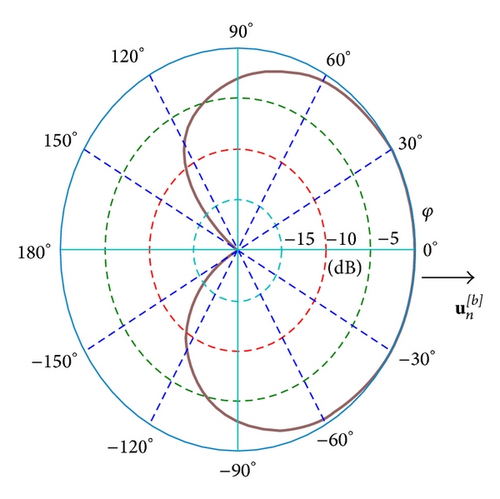
2.3. Postdiversity Process
After obtaining independent fading paths, the next criterion in diversity technique is antenna combinations. The signals received at each branch can be combined in different ways to mitigate the effects of fading. If the two signals are uncorrelated, it is rare that the two fading signals will be in a deep null at the same time. Thus, the combined signal creates a higher postcorrelation SNR (post-SNR) at the output compared to a single branch resulting in a diversity gain.
2.3.1. Multiple Antennas Combination Methods
It is necessary to synchronize the clock timings for each branch before using the antenna diversity technique. The decision module relies on the difference in the signal detection probability of each branch and performs the antenna selection, switch, and combination. Figure 3 depicts the system diagram including preprocessing module, postprocessing module, switched module, and logic decision module. Among them, the mode selection is built in logic decision module, which can perform different antenna combinations.
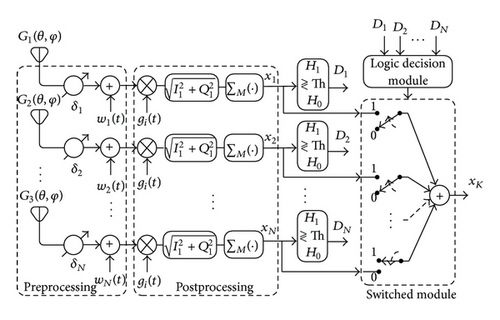
This proposed scheme can combine the received signal of each antenna through different methods, such as switched combination (SWC), selection combination (SC), equal gain combination (EGC), and maximum ratio combination (MRC) [26, 27].
2.3.2. Decision-Making Logic
In indoor environment, the signal is susceptible to multipath, blanking, and narrowband interference. A decision of all the interferences in spatial cooperative diversity technique depends on signal probability distribution model [11]. Related decision logic is a technique depicted in the literature review [29]. Effective decision logic and the selection of proper spatial cooperative diversity technique can enhance signal detection performance. In antenna diversity combination, N input signals, after despreading denoted as xi, received via N diversity branches, are considered. In the detection process for GNSS signals, the performance can be evaluated through adoption of an individual binary hypothesis testing, defined as H0 and H1. H0 corresponds to the scenario, when the incoming signal does not correspond to the hypothesis related to local replica gi, whereas, under H1 state, it is supposed that the frequency and code delay of the incoming signal are synchronized with the local replica. The detection structure for such binary hypothesis test results in the Likelihood Ratio Test (LRT), when the additive noise is zero mean Gaussian distribution [14]. The LRT for an antenna diversity structure consisting of N branches can be considered as received signal estimator followed by a correlator. The different types of antenna combination methods can be performed under condition where correlation coefficient is equal to zero [30]. Assume the incoming signal includes desired signal component, and then the signal flag Dn is set as one. Otherwise, the signal flag is set as zero. K denotes the total times of Dn = 1 (n = 1,2, …, N), which decides the type of antenna combination method. The definition of K is the same as in (7). Table 1 demonstrates the decision-making logic process for the proposed scheme. The design criterion of decision-making logic depends on K value that corresponds to the four operation modes including SC, SWC, MRC, and EGC.
| Combination mode | K |
|---|---|
| Mode 1: “SC” | 4 < K ≤ round(N/4), N > 20 |
| Mode 2: “SWC” | 4 < K ≤ round(N/2), 9 ≤ N ≤ 20 |
| Mode 3: “MRC” | 2 < K ≤ 4, N < 9 |
| Mode 4: “EGC” | K ≤ 2, N < 9 |
2.3.3. Correlation Coefficient Evaluation
3. Performance Criteria
The proposed scheme combines the polarization diversity and pattern diversity to form the desired array gain pattern. Because the right-hand circular polarization (RHCP) or linear polarization is used in common GNSS antenna, the antenna spacing is only an arrangement factor used to avoid the effect of mutual coupling and cross-polarization [14]. Therefore, this section illustrates the performance evaluation criteria of the proposed system.
3.1. Signal Detection Probability
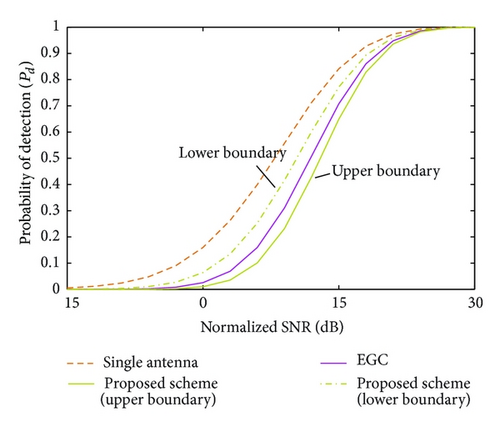
3.1.1. Diversity Gain
Figure 5 shows the reduction of the probability of fading below a given threshold or normalized SNR when increasing the number of antennas. This figure also shows that, for Γ(ρ < ρs/η) = 10% reliability level, there are diversity gains of 9.2 dB and 7.3 dB for the two-antenna and four-antenna selection combiners, respectively.
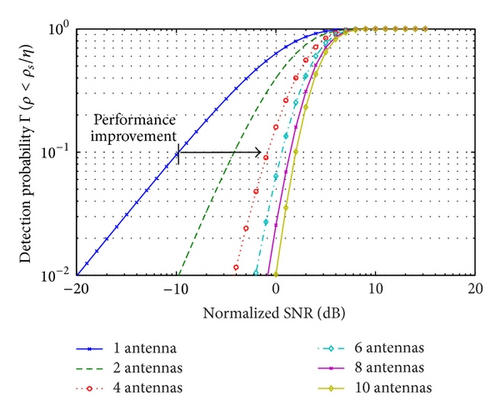
3.1.2. Correlation Coefficient
4. Test Hardware
This chapter describes hardware setup that is the use of multiple antennas for different spatial combing including switching, selection, equal gain, and maximum gain method. The establishment of antenna array system is also demonstrated in this chapter.
4.1. Hardware Specification
Figure 6 shows the mobile robot appearance. The robot is equipped with motor module, and the use of motor and gear is adopted to control the rotation speed of the antenna array. The RF front-end module and NI CB-2162 are mounted on computer side, and ends of the antennas are connected to the GPS501 hardware box. Four commercial GPS front-ends are adopted to filter, down-convert, and digitize incoming RF signal to obtain digital samples. A master clock is utilized to control the synchronization among four different channels so that the samples can be acquired simultaneously. The digitized samples are acquired at the rate of 5.714 MHz. The digital samples are obtained using a PCI-based data acquisition board (PCI-6536) through a data acquisition software (NI LabView). The data samples from each antenna element are stored and postprocessed for interference mitigation analysis. Figure 7 shows the structure of array system hardware. Firstly, switched board (NI CB-2162) acquires the “SGN” and “MAG” binary digital signal from the four RF front-end modules. After that, the 8 bit signal, which consists of four groups of “SGN” and “MAG” signal, is sent to an NI PCIe-6536 high-speed digital I/O cards and then stored in the personal computer. The NovAtel reference antenna is adopted to estimate the Doppler frequency, code phase, and navigation data bits, and these estimates are utilized to demodulate the GPS digital intermediate frequency (IF) data with respect to the indoor antenna.
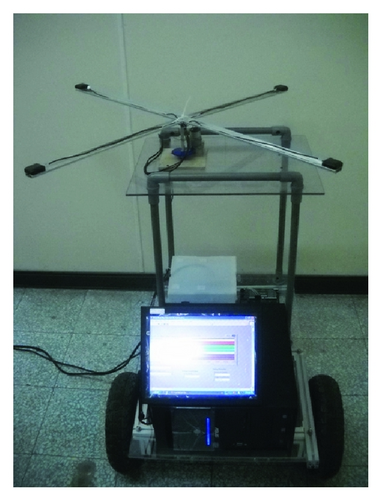
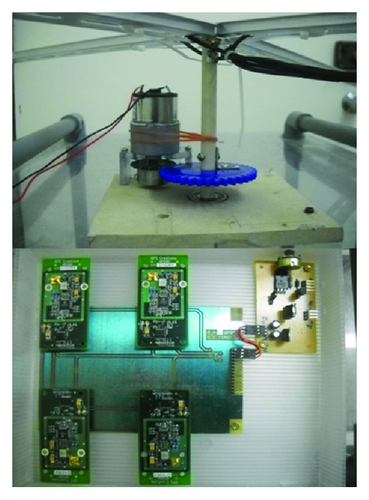
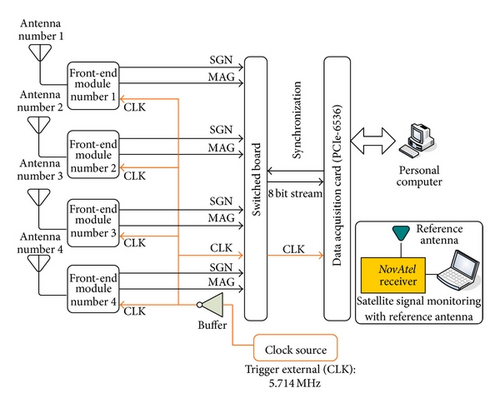
4.2. Experimental Setup
The two selected indoor locations are situated at biomechatronics engineering building, namely, the BIOME building of Pingtung University of Science and Technology (NPUST). Figure 8 illustrates the schematic plan view of the second floor of the building and the indoor test locations. The first location is situated in a corridor, and the other location is inside a room of the 2nd floor. The indoor test location number 1 inside the corridor has its southern view blocked with the building wall, but northern of the antenna is open through the glass windows. For verification purposes, a second location on the same floor of the same building is also investigated. The patch antenna indoors are facing the glass window panes towards the western direction. Figure 9 depicts the sky-view plot at the time as recorded by the reference receiver (NovAtel Inc.) located at the rooftop. The roof reference antenna is stationary; the indoor patch antennas are mounted on a rotation platform. The antenna spacing is set as 1 λ. The experiments are divided into static and dynamic scenarios, respectively. After that, the received data is stored and processed using MATLAB software for signal acquisition and tracking.
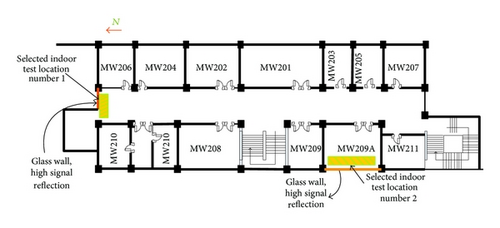

5. Experimental Results
This chapter analyzes the performance of proposed scheme through experiments. The initial step is to have a mobile robot to move to the designated position. Upon arrival, the mobile robot stops moving and starts its experiment of static signal reception. The duration of static data is half an hour. The dynamic rotation speeds are 1, 4, and 20 rpm. The reception time in terms of dynamic data is half an hour. The above data are utilized for the performance analysis using the following three steps. First of all, the indoor fading scenario for all of the antennas is demonstrated, where the C/N0 distribution characteristics indicate the indoor fading scenario with respect to envelope correlation and Rician factor. The envelope correlation is compared with the theoretical correlation coefficient as the antenna spacing varies. Secondly, the effects of cooperative combination are depicted. The effects of EGC and the proposed scheme are particularly compared. Besides, the comparison with single antenna case is also conducted, and post-SNR improvements for the proposed decision scheme are also described. At last, analyses with receiver operating characteristics (ROC) curves with regard to improvement in detection probability in contrast to that of the single antenna processing are demonstrated.
5.1. Fading Environment
It is necessary to extend coherent integration time to obtain high-sensitivity operation due to weak and severe nonline of sight (NLOS) signal conditions in indoors. Coherent and noncoherent integration times are 8 ms and 1 sec, respectively. As an example of indoor fading characteristics, C/N0 over the time for PRN 3 corresponding to the dataset with 1 λ antenna spacing is shown in Figure 10. The average C/N0 for all of the antennas is roughly 25.1 dB-Hz. Figure 11 demonstrates the acquisition result of a weak GPS signal (PRN 3) from each antenna with 1 λ antenna spacing, where the correlation peak is also zoomed in plots of Doppler frequency and code offset.
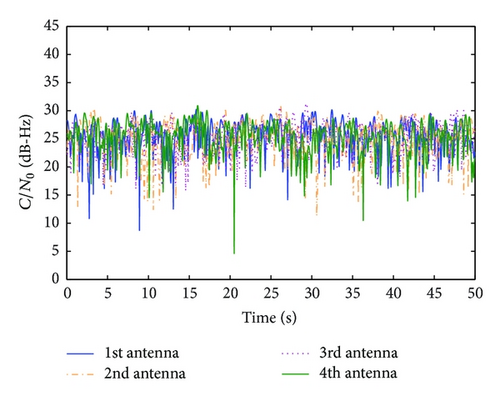
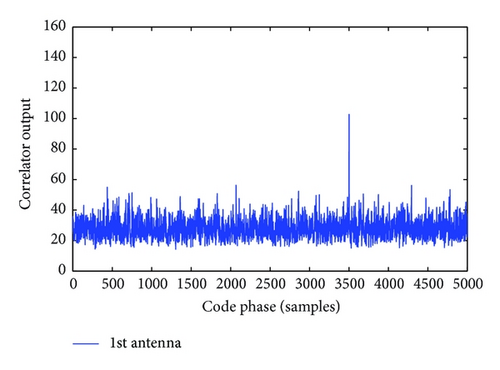
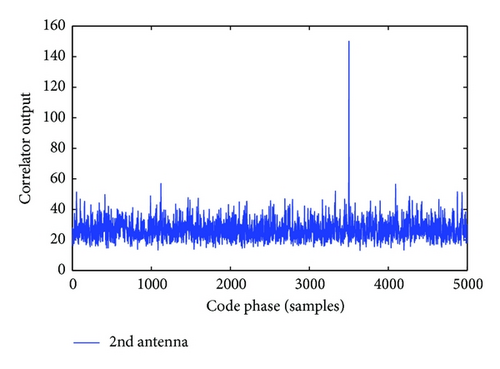
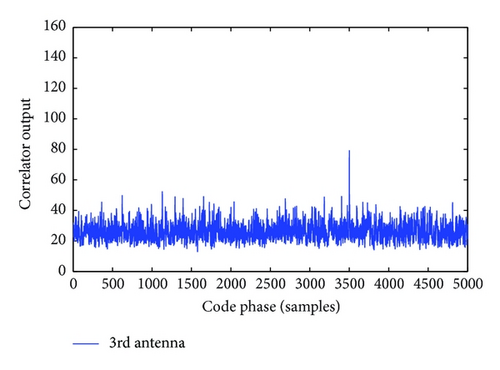
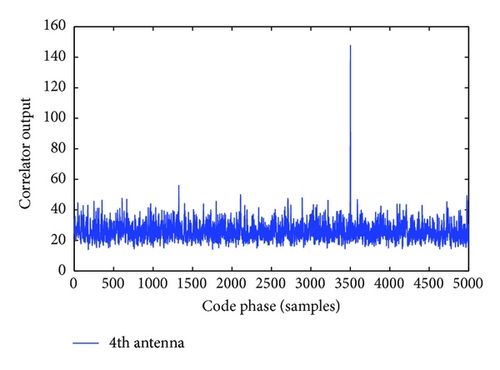
In Figure 12, the average antenna correlation acquired through experimental measurements supports the theoretical envelope correlation prediction demonstrated in (12). This figure illustrates that the measured antenna envelope correlation is lower than the theoretical correlation curve, especially in terms of smaller antenna spacing. This is because the indoor patch antenna employed in this paper is not an ideal one, and the radiation pattern of the indoor patch antenna is not omnidirectional. Figure 12 depicts that the measured squared magnitude envelopes maintain a similar shape for all of the available pseudorandom noise (PRNs), but they differ with respect to the actual correlation value. This is because the actual antenna envelope correlation counts on the angular multipath spread in addition to the antenna characteristics.
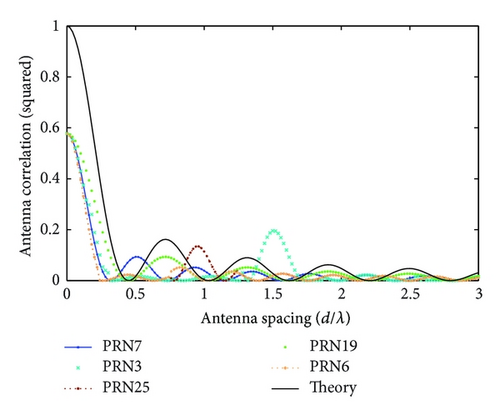
Figure 13 depicts the deflection coefficient measures for the single and proposed decision schemes corresponding to the indoor data set of 0.5 λ antenna spacing for PRN 19. The cumulative distribution function is also plotted for the same dataset. The deflection coefficient for the spatial combination techniques has gone through a lower number of fades in contrast to the single antenna processing. Correspondingly, the deflection coefficient values increase drastically for a smaller value of cumulative probability. The performance gap between single antenna and diversity antennas and the performance improvement results from the diversity gain with cooperative signal combination are also shown in Figure 13.
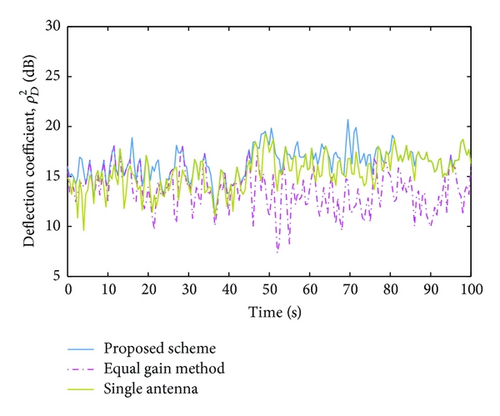
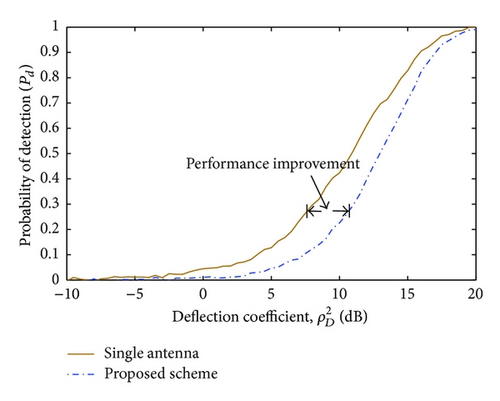
Figure 14 shows the results of a research on the achievable post-SNR for the different antenna spacings averaged over all PRNs. A coherent integration period of 5 ms and a total observation period of 1 s for noncoherent summation are taken into account. Both EGC and proposed scheme show better performance than single antenna performance. Nevertheless, proposed scheme presents a slightly superior performance in contrast to that of EGC. This is because the performance of proposed scheme is affected by the correlation coefficients between the antennas. The correlation coefficient is reduced by increasing the antenna spacing, and both EGC and proposed scheme present similar performance.
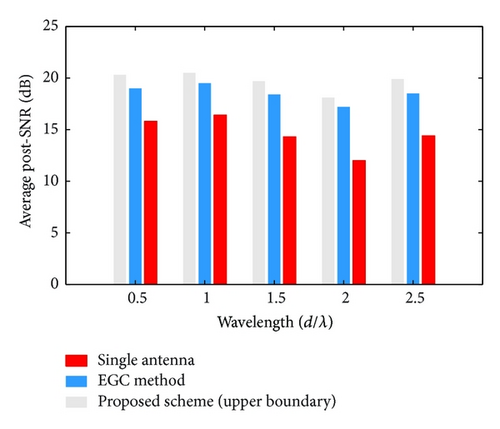
5.2. Post-SNR
Table 2 illustrates the average post-SNR results that use different types of cooperative diversity method under the worst case. In Table 2, the proposed scheme with 1 λ antenna spacing provides 2.3 dB post-SNR performance enhancement in contrast to EGC method under the static experiment (without antenna array rotation). The performance of proposed scheme is the same as that of MRC method. In addition, only the use of proposed scheme with 1 λ antenna spacing and 20 rpm can acquire the desired signal under the dynamic experiment (with antenna array rotation).
| Average post-SNR (Th: 17 dB) | Single antenna case | SWC | MRC | EGC | Proposed scheme | |||
|---|---|---|---|---|---|---|---|---|
1st antenna (North) |
2nd antenna (East) |
3rd antenna (South) |
4th antenna (West) |
|||||
| Static experiment (PRN 19) | ||||||||
| 0.5 λ | × | 17.3 | 17.3 | 17.7 | 17.3~17.7 | 19.5 | 18.3 | 19.5 |
| 1 λ | 17.9 | 17.8 | 17.9 | 18.3 | 17.8~18.3 | 20.9 | 18.6 | 20.9 |
| 2.5 λ | × | × | × | × | × | 19.1 | 18.0 | 19.1 |
| Dynamic experiment (PRN 19; antenna spacing: 1 λ) | ||||||||
| 1 rpm | 17.7 | 17.5 | 17.7 | 17.9 | 17.5~17.9 | 18.8 | 18.5 | 18.8 |
| 4 rpm | 17.7 | 17.3 | 17.1 | 17.0 | 17.1~17.7 | 17.5 | × | 17.5 |
| 20 rpm | × | × | 17.4 | 17.1 | × | 18.7 | × | 18.7 |
- “×”: unlocked.
5.3. Detection Performance
Performance evaluation with respect to the deflection coefficient is only a rough account of the improvements, not an accurate measure. Thus, the detection performance has been conducted based on the indoor test data in the form of ROC. The coherent integration period of 100 ms results in good probability of the detection. So as to acquire test statistics for H1, that is, under the presence of a signal, the correct code phase estimate is adopted and the corresponding detection output is computed. Incorrect code phase is employed to obtain the test statistics under H0 condition. The average post-SNR values for the PRN processed in the dataset for the static experiment are in the range from 17 to 20 dB-Hz. Figure 15 depicts the CDF of the detection output for single antenna and cooperative antennas at 1 λ antenna spacing. The detection output was based on 100 ms coherent integration time and 6 sec noncoherent integration time. Under H0 and H1 hypotheses, single antenna performance and cooperative combination with EG and proposed scheme are demonstrated. Figure 15 readily presents the advantages of adopting multiple antennas for signal detection purposes. For any given percentage of time, the proposed scheme presents slightly superior detection performance than that of EGC.
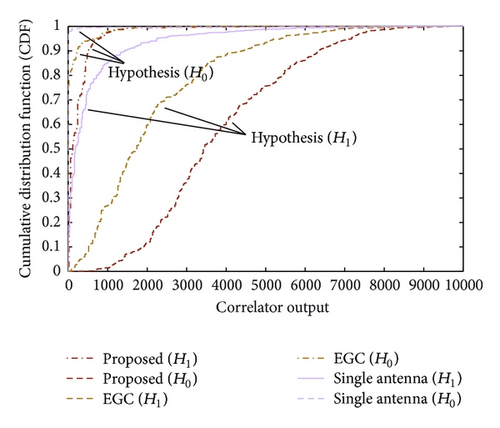
6. Conclusion
This research demonstrates the dynamic cooperative scheme to enhance the signal detection performance with regard to multiple antennas under indoor environment. Simulation result illustrates that the use of multiple antennas with decision logic scheme can effectively improve post-SNR performance in contrast to single antenna case. Meanwhile, real-time data reception is conducted under indoor environment. It is successfully verified that the proposed scheme indeed effectively enhances signal detection probability and improve post-SNR. In the future, this technique can combine beamforming algorithm to be applied to the multinavigation satellite signal reception and the interference mitigation system.
Acknowledgments
Many thanks are due to the editor and reviewers for their valuable comments to refine this paper. Besides, the authors would like to thank the National Science Council in Taiwan for supporting this research under Grant NSC 102-2221-E-020-007.




